MGT502 - Communication's Role in Employee Knowledge Development
VerifiedAdded on 2023/06/10
|8
|1547
|169
Report
AI Summary
This report examines the crucial role of communication in employee knowledge development within a business context. It highlights the significance of effective communication skills for career success and organizational growth, addressing issues arising from a lack of communication, particularly in multinational companies. The study emphasizes the importance of employee induction processes and integrated communication in onboarding, contributing to employee retention and overall organizational development. It also explores practical considerations for effective business communication, focusing on cultural aspects and behavioral patterns. The report concludes that a well-structured communication strategy during employee induction enhances engagement, productivity, and the alignment of new employees with the company's culture and objectives. Desklib offers a range of solved assignments and past papers to support students' learning needs.
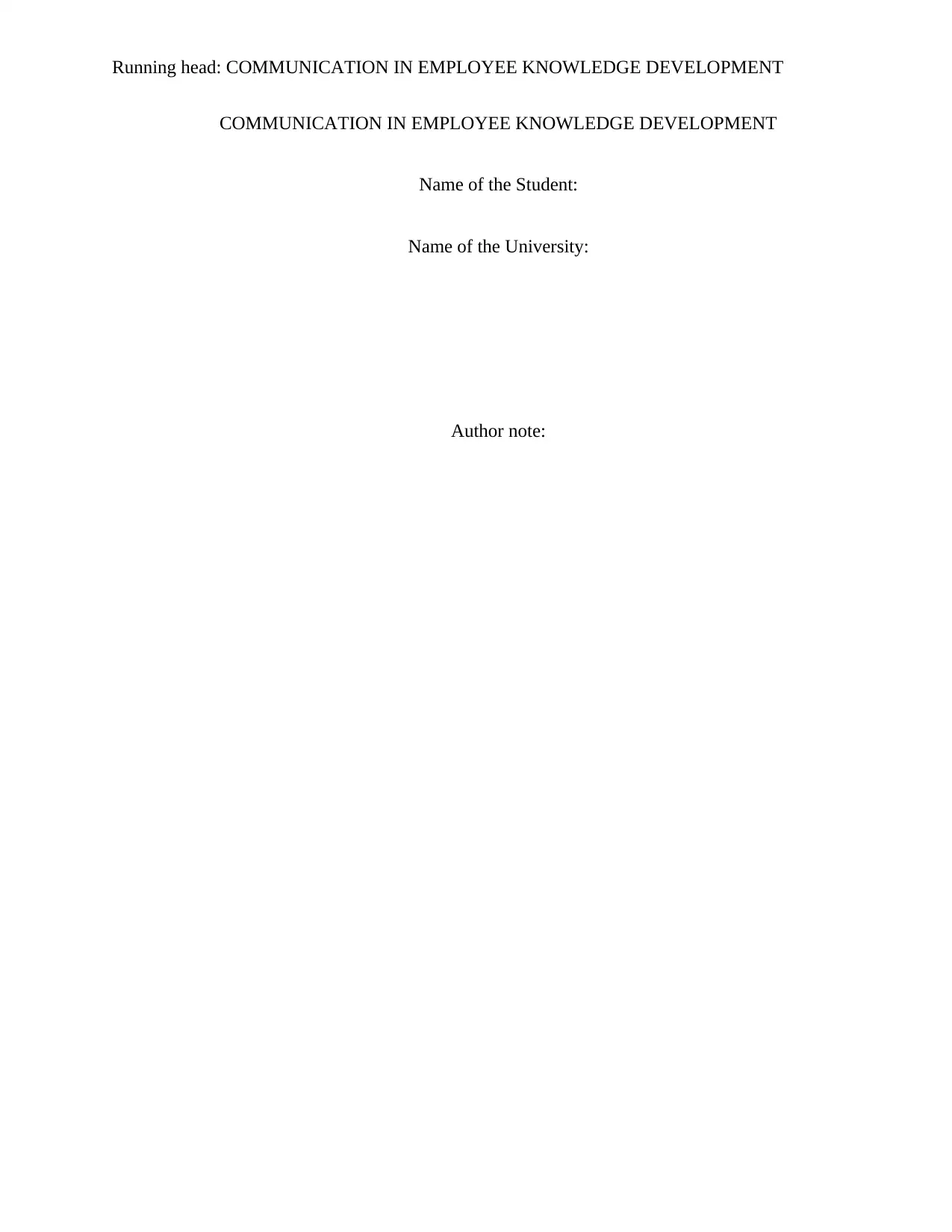
Running head: COMMUNICATION IN EMPLOYEE KNOWLEDGE DEVELOPMENT
COMMUNICATION IN EMPLOYEE KNOWLEDGE DEVELOPMENT
Name of the Student:
Name of the University:
Author note:
COMMUNICATION IN EMPLOYEE KNOWLEDGE DEVELOPMENT
Name of the Student:
Name of the University:
Author note:
Paraphrase This Document
Need a fresh take? Get an instant paraphrase of this document with our AI Paraphraser
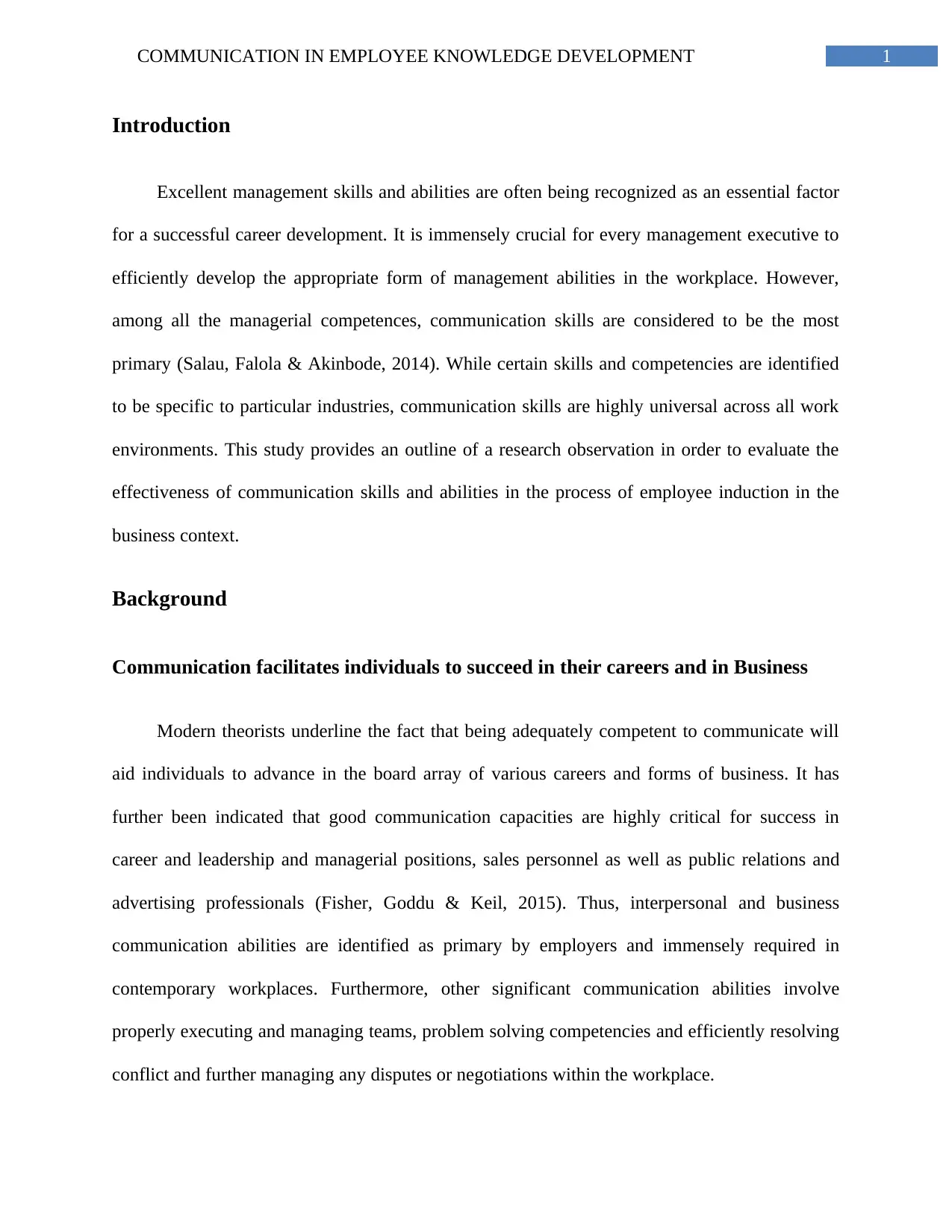
1COMMUNICATION IN EMPLOYEE KNOWLEDGE DEVELOPMENT
Introduction
Excellent management skills and abilities are often being recognized as an essential factor
for a successful career development. It is immensely crucial for every management executive to
efficiently develop the appropriate form of management abilities in the workplace. However,
among all the managerial competences, communication skills are considered to be the most
primary (Salau, Falola & Akinbode, 2014). While certain skills and competencies are identified
to be specific to particular industries, communication skills are highly universal across all work
environments. This study provides an outline of a research observation in order to evaluate the
effectiveness of communication skills and abilities in the process of employee induction in the
business context.
Background
Communication facilitates individuals to succeed in their careers and in Business
Modern theorists underline the fact that being adequately competent to communicate will
aid individuals to advance in the board array of various careers and forms of business. It has
further been indicated that good communication capacities are highly critical for success in
career and leadership and managerial positions, sales personnel as well as public relations and
advertising professionals (Fisher, Goddu & Keil, 2015). Thus, interpersonal and business
communication abilities are identified as primary by employers and immensely required in
contemporary workplaces. Furthermore, other significant communication abilities involve
properly executing and managing teams, problem solving competencies and efficiently resolving
conflict and further managing any disputes or negotiations within the workplace.
Introduction
Excellent management skills and abilities are often being recognized as an essential factor
for a successful career development. It is immensely crucial for every management executive to
efficiently develop the appropriate form of management abilities in the workplace. However,
among all the managerial competences, communication skills are considered to be the most
primary (Salau, Falola & Akinbode, 2014). While certain skills and competencies are identified
to be specific to particular industries, communication skills are highly universal across all work
environments. This study provides an outline of a research observation in order to evaluate the
effectiveness of communication skills and abilities in the process of employee induction in the
business context.
Background
Communication facilitates individuals to succeed in their careers and in Business
Modern theorists underline the fact that being adequately competent to communicate will
aid individuals to advance in the board array of various careers and forms of business. It has
further been indicated that good communication capacities are highly critical for success in
career and leadership and managerial positions, sales personnel as well as public relations and
advertising professionals (Fisher, Goddu & Keil, 2015). Thus, interpersonal and business
communication abilities are identified as primary by employers and immensely required in
contemporary workplaces. Furthermore, other significant communication abilities involve
properly executing and managing teams, problem solving competencies and efficiently resolving
conflict and further managing any disputes or negotiations within the workplace.
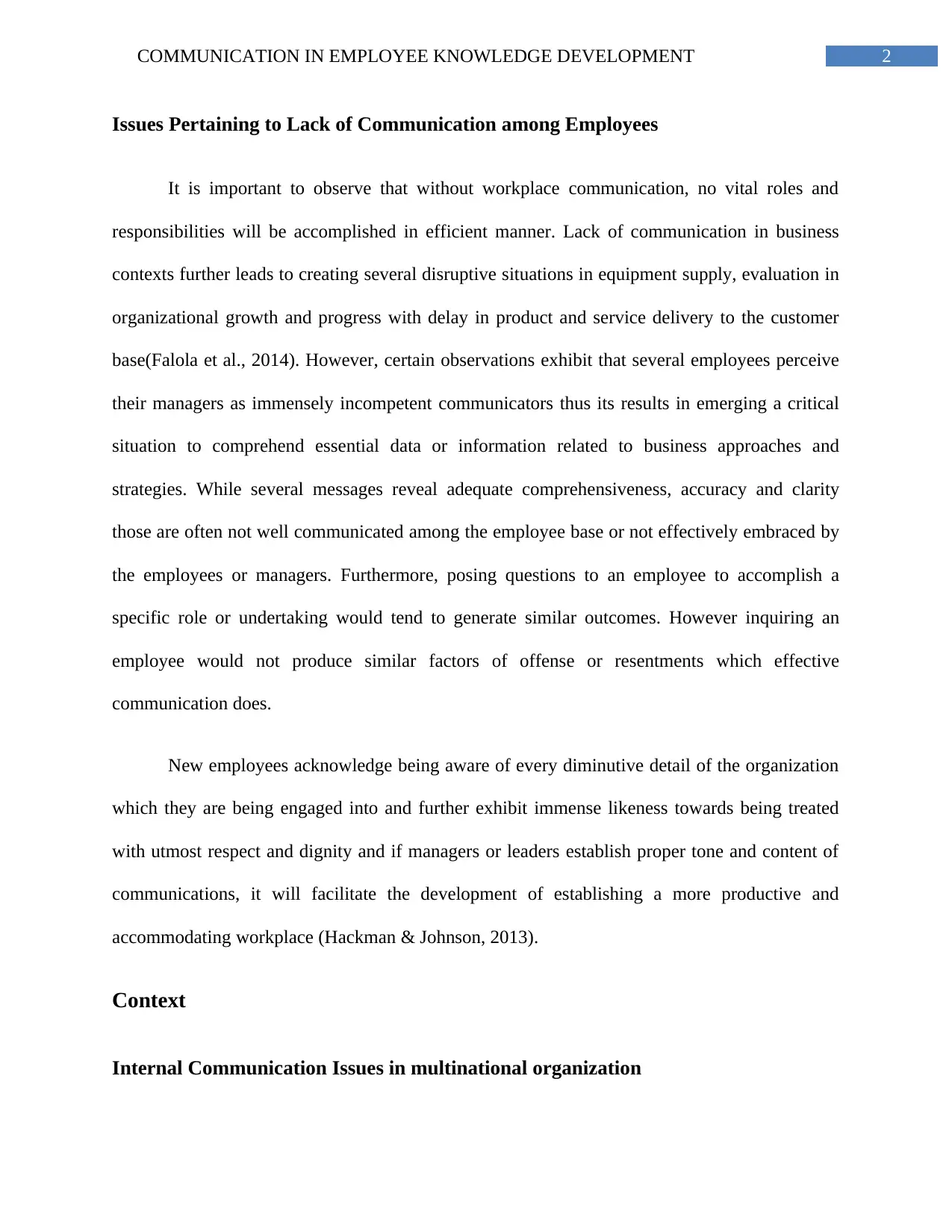
2COMMUNICATION IN EMPLOYEE KNOWLEDGE DEVELOPMENT
Issues Pertaining to Lack of Communication among Employees
It is important to observe that without workplace communication, no vital roles and
responsibilities will be accomplished in efficient manner. Lack of communication in business
contexts further leads to creating several disruptive situations in equipment supply, evaluation in
organizational growth and progress with delay in product and service delivery to the customer
base(Falola et al., 2014). However, certain observations exhibit that several employees perceive
their managers as immensely incompetent communicators thus its results in emerging a critical
situation to comprehend essential data or information related to business approaches and
strategies. While several messages reveal adequate comprehensiveness, accuracy and clarity
those are often not well communicated among the employee base or not effectively embraced by
the employees or managers. Furthermore, posing questions to an employee to accomplish a
specific role or undertaking would tend to generate similar outcomes. However inquiring an
employee would not produce similar factors of offense or resentments which effective
communication does.
New employees acknowledge being aware of every diminutive detail of the organization
which they are being engaged into and further exhibit immense likeness towards being treated
with utmost respect and dignity and if managers or leaders establish proper tone and content of
communications, it will facilitate the development of establishing a more productive and
accommodating workplace (Hackman & Johnson, 2013).
Context
Internal Communication Issues in multinational organization
Issues Pertaining to Lack of Communication among Employees
It is important to observe that without workplace communication, no vital roles and
responsibilities will be accomplished in efficient manner. Lack of communication in business
contexts further leads to creating several disruptive situations in equipment supply, evaluation in
organizational growth and progress with delay in product and service delivery to the customer
base(Falola et al., 2014). However, certain observations exhibit that several employees perceive
their managers as immensely incompetent communicators thus its results in emerging a critical
situation to comprehend essential data or information related to business approaches and
strategies. While several messages reveal adequate comprehensiveness, accuracy and clarity
those are often not well communicated among the employee base or not effectively embraced by
the employees or managers. Furthermore, posing questions to an employee to accomplish a
specific role or undertaking would tend to generate similar outcomes. However inquiring an
employee would not produce similar factors of offense or resentments which effective
communication does.
New employees acknowledge being aware of every diminutive detail of the organization
which they are being engaged into and further exhibit immense likeness towards being treated
with utmost respect and dignity and if managers or leaders establish proper tone and content of
communications, it will facilitate the development of establishing a more productive and
accommodating workplace (Hackman & Johnson, 2013).
Context
Internal Communication Issues in multinational organization
⊘ This is a preview!⊘
Do you want full access?
Subscribe today to unlock all pages.

Trusted by 1+ million students worldwide
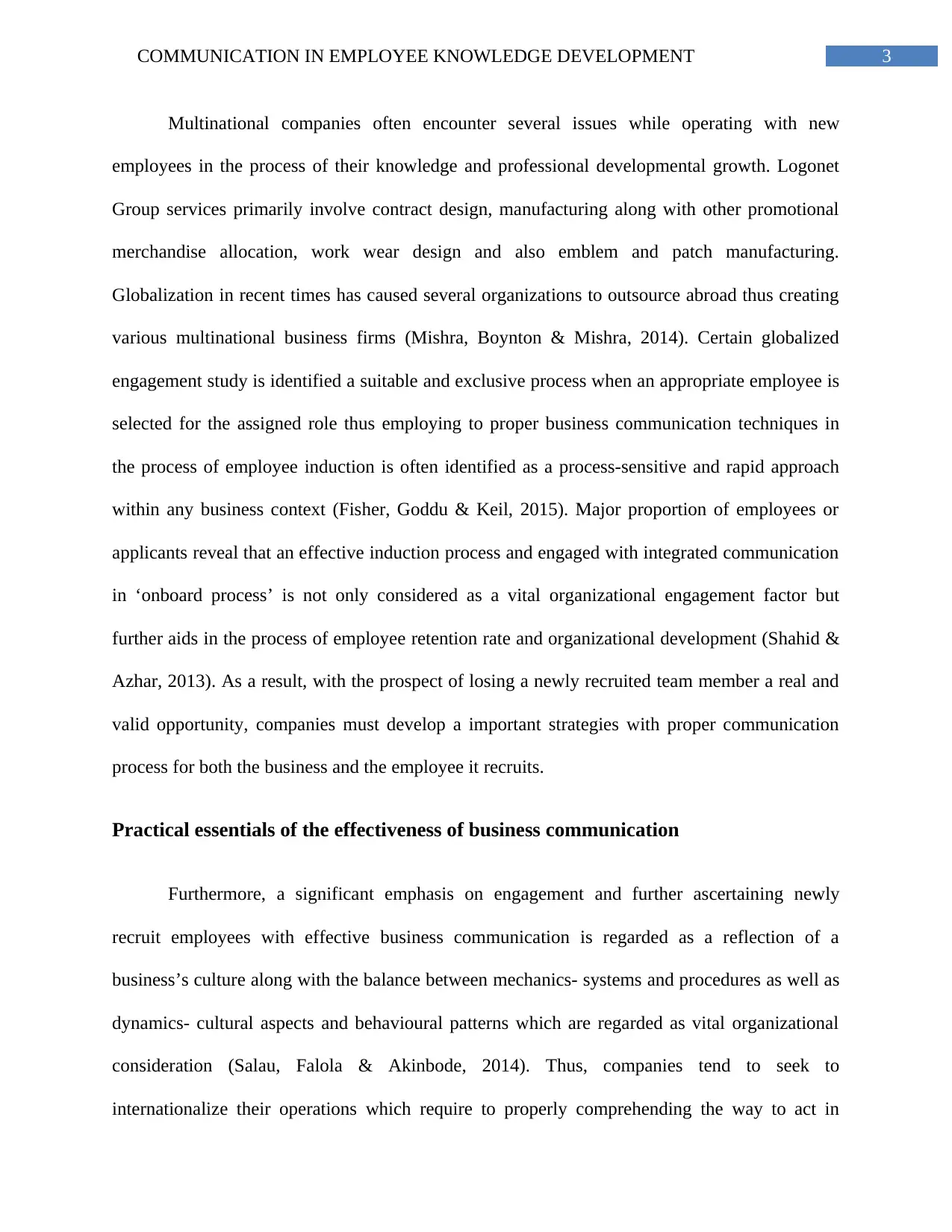
3COMMUNICATION IN EMPLOYEE KNOWLEDGE DEVELOPMENT
Multinational companies often encounter several issues while operating with new
employees in the process of their knowledge and professional developmental growth. Logonet
Group services primarily involve contract design, manufacturing along with other promotional
merchandise allocation, work wear design and also emblem and patch manufacturing.
Globalization in recent times has caused several organizations to outsource abroad thus creating
various multinational business firms (Mishra, Boynton & Mishra, 2014). Certain globalized
engagement study is identified a suitable and exclusive process when an appropriate employee is
selected for the assigned role thus employing to proper business communication techniques in
the process of employee induction is often identified as a process-sensitive and rapid approach
within any business context (Fisher, Goddu & Keil, 2015). Major proportion of employees or
applicants reveal that an effective induction process and engaged with integrated communication
in ‘onboard process’ is not only considered as a vital organizational engagement factor but
further aids in the process of employee retention rate and organizational development (Shahid &
Azhar, 2013). As a result, with the prospect of losing a newly recruited team member a real and
valid opportunity, companies must develop a important strategies with proper communication
process for both the business and the employee it recruits.
Practical essentials of the effectiveness of business communication
Furthermore, a significant emphasis on engagement and further ascertaining newly
recruit employees with effective business communication is regarded as a reflection of a
business’s culture along with the balance between mechanics- systems and procedures as well as
dynamics- cultural aspects and behavioural patterns which are regarded as vital organizational
consideration (Salau, Falola & Akinbode, 2014). Thus, companies tend to seek to
internationalize their operations which require to properly comprehending the way to act in
Multinational companies often encounter several issues while operating with new
employees in the process of their knowledge and professional developmental growth. Logonet
Group services primarily involve contract design, manufacturing along with other promotional
merchandise allocation, work wear design and also emblem and patch manufacturing.
Globalization in recent times has caused several organizations to outsource abroad thus creating
various multinational business firms (Mishra, Boynton & Mishra, 2014). Certain globalized
engagement study is identified a suitable and exclusive process when an appropriate employee is
selected for the assigned role thus employing to proper business communication techniques in
the process of employee induction is often identified as a process-sensitive and rapid approach
within any business context (Fisher, Goddu & Keil, 2015). Major proportion of employees or
applicants reveal that an effective induction process and engaged with integrated communication
in ‘onboard process’ is not only considered as a vital organizational engagement factor but
further aids in the process of employee retention rate and organizational development (Shahid &
Azhar, 2013). As a result, with the prospect of losing a newly recruited team member a real and
valid opportunity, companies must develop a important strategies with proper communication
process for both the business and the employee it recruits.
Practical essentials of the effectiveness of business communication
Furthermore, a significant emphasis on engagement and further ascertaining newly
recruit employees with effective business communication is regarded as a reflection of a
business’s culture along with the balance between mechanics- systems and procedures as well as
dynamics- cultural aspects and behavioural patterns which are regarded as vital organizational
consideration (Salau, Falola & Akinbode, 2014). Thus, companies tend to seek to
internationalize their operations which require to properly comprehending the way to act in
Paraphrase This Document
Need a fresh take? Get an instant paraphrase of this document with our AI Paraphraser
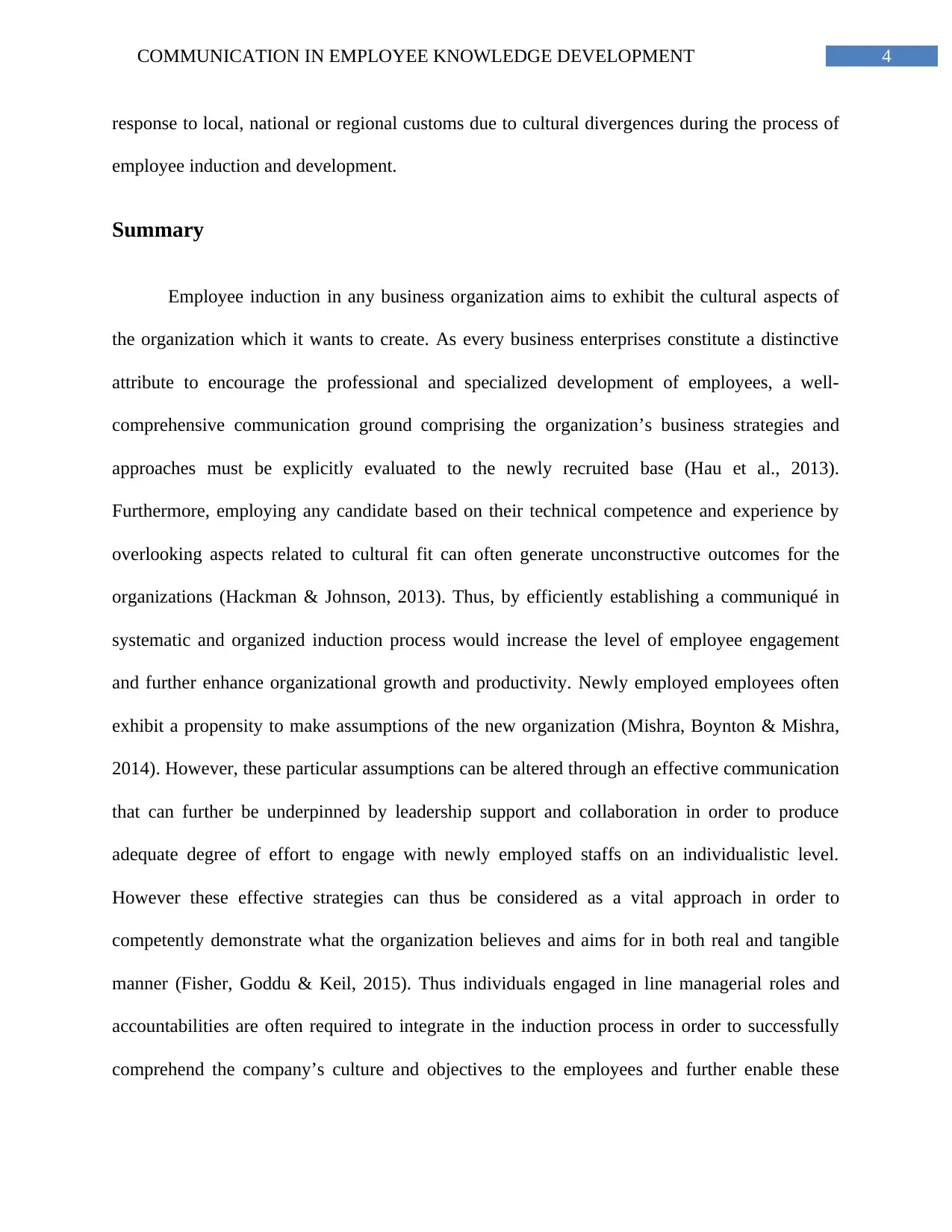
4COMMUNICATION IN EMPLOYEE KNOWLEDGE DEVELOPMENT
response to local, national or regional customs due to cultural divergences during the process of
employee induction and development.
Summary
Employee induction in any business organization aims to exhibit the cultural aspects of
the organization which it wants to create. As every business enterprises constitute a distinctive
attribute to encourage the professional and specialized development of employees, a well-
comprehensive communication ground comprising the organization’s business strategies and
approaches must be explicitly evaluated to the newly recruited base (Hau et al., 2013).
Furthermore, employing any candidate based on their technical competence and experience by
overlooking aspects related to cultural fit can often generate unconstructive outcomes for the
organizations (Hackman & Johnson, 2013). Thus, by efficiently establishing a communiqué in
systematic and organized induction process would increase the level of employee engagement
and further enhance organizational growth and productivity. Newly employed employees often
exhibit a propensity to make assumptions of the new organization (Mishra, Boynton & Mishra,
2014). However, these particular assumptions can be altered through an effective communication
that can further be underpinned by leadership support and collaboration in order to produce
adequate degree of effort to engage with newly employed staffs on an individualistic level.
However these effective strategies can thus be considered as a vital approach in order to
competently demonstrate what the organization believes and aims for in both real and tangible
manner (Fisher, Goddu & Keil, 2015). Thus individuals engaged in line managerial roles and
accountabilities are often required to integrate in the induction process in order to successfully
comprehend the company’s culture and objectives to the employees and further enable these
response to local, national or regional customs due to cultural divergences during the process of
employee induction and development.
Summary
Employee induction in any business organization aims to exhibit the cultural aspects of
the organization which it wants to create. As every business enterprises constitute a distinctive
attribute to encourage the professional and specialized development of employees, a well-
comprehensive communication ground comprising the organization’s business strategies and
approaches must be explicitly evaluated to the newly recruited base (Hau et al., 2013).
Furthermore, employing any candidate based on their technical competence and experience by
overlooking aspects related to cultural fit can often generate unconstructive outcomes for the
organizations (Hackman & Johnson, 2013). Thus, by efficiently establishing a communiqué in
systematic and organized induction process would increase the level of employee engagement
and further enhance organizational growth and productivity. Newly employed employees often
exhibit a propensity to make assumptions of the new organization (Mishra, Boynton & Mishra,
2014). However, these particular assumptions can be altered through an effective communication
that can further be underpinned by leadership support and collaboration in order to produce
adequate degree of effort to engage with newly employed staffs on an individualistic level.
However these effective strategies can thus be considered as a vital approach in order to
competently demonstrate what the organization believes and aims for in both real and tangible
manner (Fisher, Goddu & Keil, 2015). Thus individuals engaged in line managerial roles and
accountabilities are often required to integrate in the induction process in order to successfully
comprehend the company’s culture and objectives to the employees and further enable these
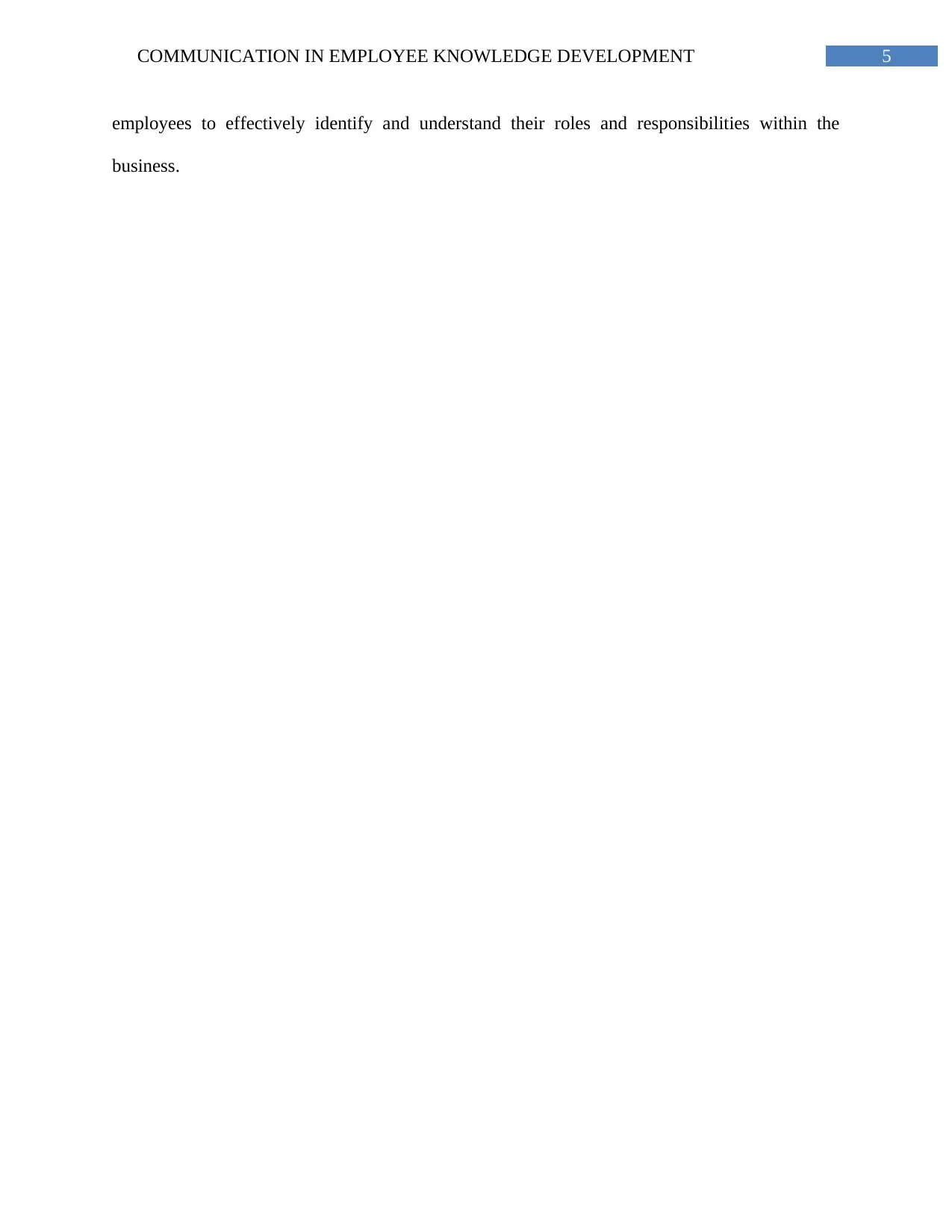
5COMMUNICATION IN EMPLOYEE KNOWLEDGE DEVELOPMENT
employees to effectively identify and understand their roles and responsibilities within the
business.
employees to effectively identify and understand their roles and responsibilities within the
business.
⊘ This is a preview!⊘
Do you want full access?
Subscribe today to unlock all pages.

Trusted by 1+ million students worldwide
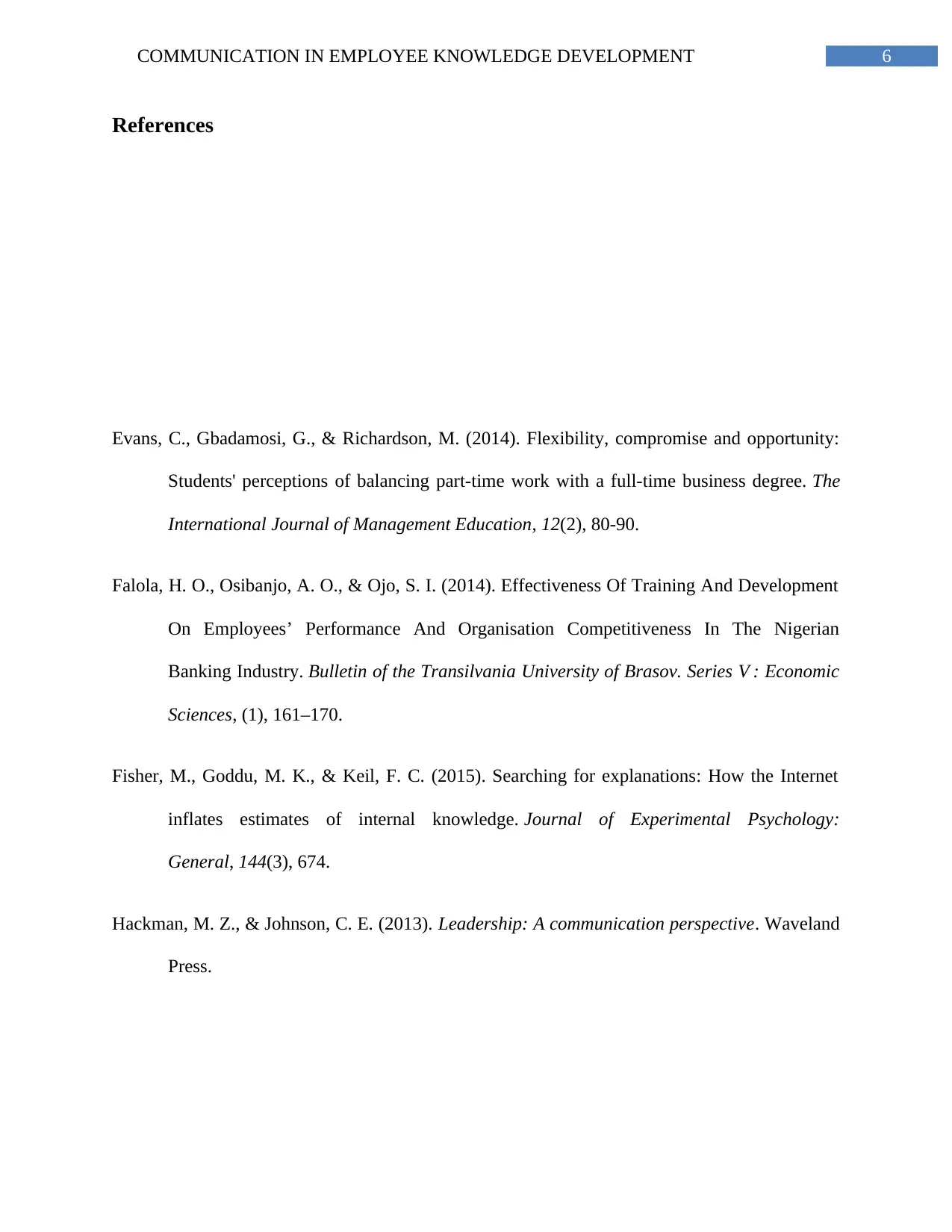
6COMMUNICATION IN EMPLOYEE KNOWLEDGE DEVELOPMENT
References
Evans, C., Gbadamosi, G., & Richardson, M. (2014). Flexibility, compromise and opportunity:
Students' perceptions of balancing part-time work with a full-time business degree. The
International Journal of Management Education, 12(2), 80-90.
Falola, H. O., Osibanjo, A. O., & Ojo, S. I. (2014). Effectiveness Of Training And Development
On Employees’ Performance And Organisation Competitiveness In The Nigerian
Banking Industry. Bulletin of the Transilvania University of Brasov. Series V : Economic
Sciences, (1), 161–170.
Fisher, M., Goddu, M. K., & Keil, F. C. (2015). Searching for explanations: How the Internet
inflates estimates of internal knowledge. Journal of Experimental Psychology:
General, 144(3), 674.
Hackman, M. Z., & Johnson, C. E. (2013). Leadership: A communication perspective. Waveland
Press.
References
Evans, C., Gbadamosi, G., & Richardson, M. (2014). Flexibility, compromise and opportunity:
Students' perceptions of balancing part-time work with a full-time business degree. The
International Journal of Management Education, 12(2), 80-90.
Falola, H. O., Osibanjo, A. O., & Ojo, S. I. (2014). Effectiveness Of Training And Development
On Employees’ Performance And Organisation Competitiveness In The Nigerian
Banking Industry. Bulletin of the Transilvania University of Brasov. Series V : Economic
Sciences, (1), 161–170.
Fisher, M., Goddu, M. K., & Keil, F. C. (2015). Searching for explanations: How the Internet
inflates estimates of internal knowledge. Journal of Experimental Psychology:
General, 144(3), 674.
Hackman, M. Z., & Johnson, C. E. (2013). Leadership: A communication perspective. Waveland
Press.
Paraphrase This Document
Need a fresh take? Get an instant paraphrase of this document with our AI Paraphraser
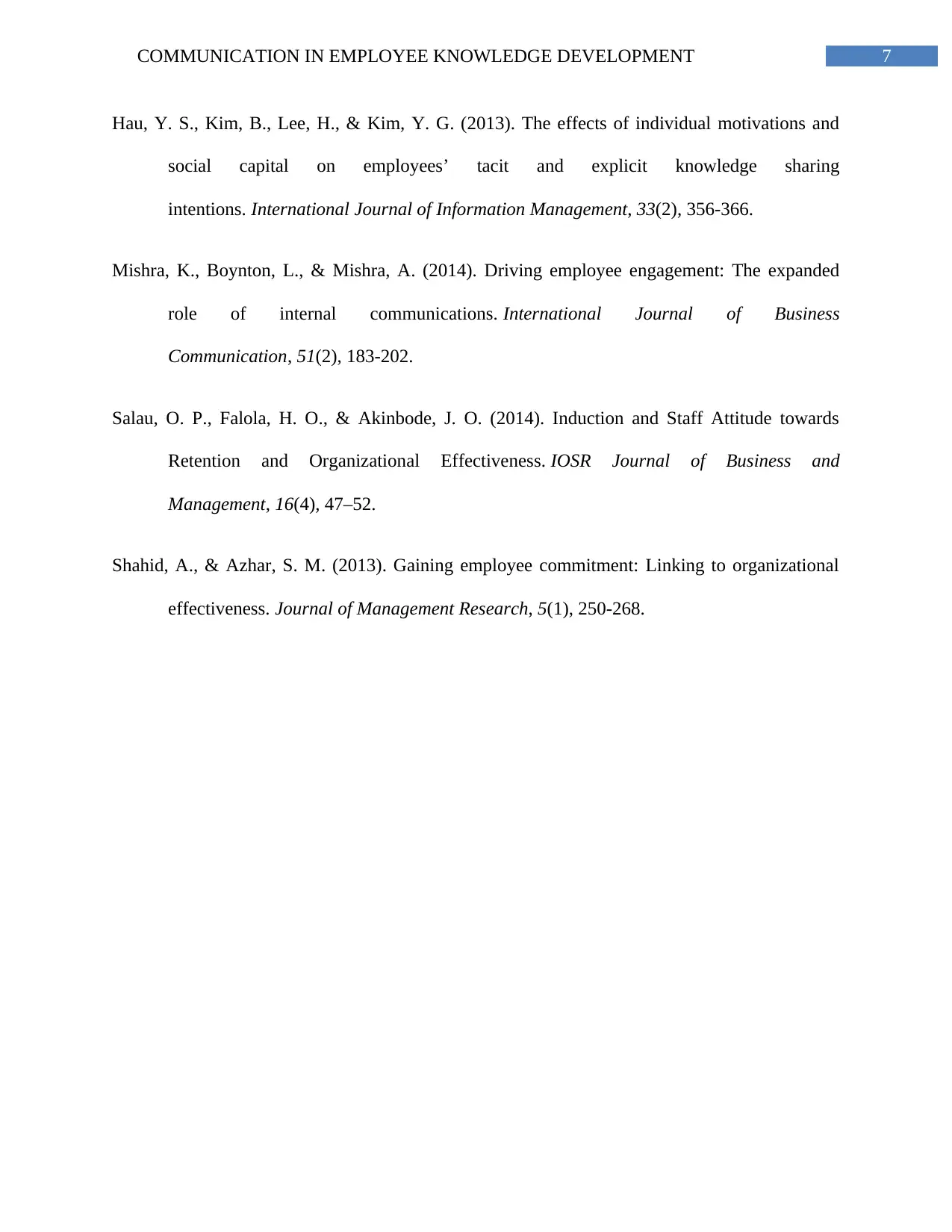
7COMMUNICATION IN EMPLOYEE KNOWLEDGE DEVELOPMENT
Hau, Y. S., Kim, B., Lee, H., & Kim, Y. G. (2013). The effects of individual motivations and
social capital on employees’ tacit and explicit knowledge sharing
intentions. International Journal of Information Management, 33(2), 356-366.
Mishra, K., Boynton, L., & Mishra, A. (2014). Driving employee engagement: The expanded
role of internal communications. International Journal of Business
Communication, 51(2), 183-202.
Salau, O. P., Falola, H. O., & Akinbode, J. O. (2014). Induction and Staff Attitude towards
Retention and Organizational Effectiveness. IOSR Journal of Business and
Management, 16(4), 47–52.
Shahid, A., & Azhar, S. M. (2013). Gaining employee commitment: Linking to organizational
effectiveness. Journal of Management Research, 5(1), 250-268.
Hau, Y. S., Kim, B., Lee, H., & Kim, Y. G. (2013). The effects of individual motivations and
social capital on employees’ tacit and explicit knowledge sharing
intentions. International Journal of Information Management, 33(2), 356-366.
Mishra, K., Boynton, L., & Mishra, A. (2014). Driving employee engagement: The expanded
role of internal communications. International Journal of Business
Communication, 51(2), 183-202.
Salau, O. P., Falola, H. O., & Akinbode, J. O. (2014). Induction and Staff Attitude towards
Retention and Organizational Effectiveness. IOSR Journal of Business and
Management, 16(4), 47–52.
Shahid, A., & Azhar, S. M. (2013). Gaining employee commitment: Linking to organizational
effectiveness. Journal of Management Research, 5(1), 250-268.
1 out of 8
Related Documents
Your All-in-One AI-Powered Toolkit for Academic Success.
+13062052269
info@desklib.com
Available 24*7 on WhatsApp / Email
![[object Object]](/_next/static/media/star-bottom.7253800d.svg)
Unlock your academic potential
Copyright © 2020–2025 A2Z Services. All Rights Reserved. Developed and managed by ZUCOL.




